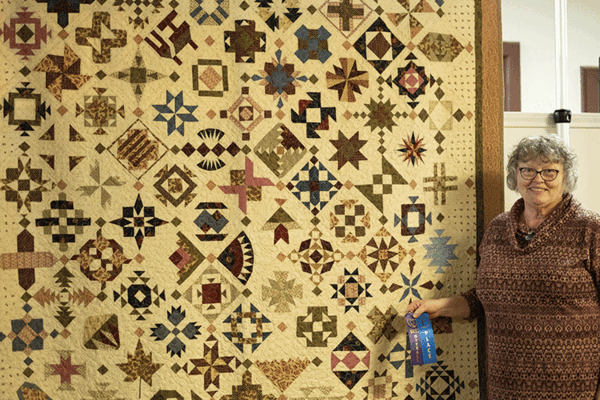 According to Vernon Weckbacher, Mission Historical Museum’s archivist, the 17th annual MHM’s Quilt Show was a success. Although there were fewer quilts than in past years, they each had a distinctive character with none resembling the others.
According to Vernon Weckbacher, Mission Historical Museum’s archivist, the 17th annual MHM’s Quilt Show was a success. Although there were fewer quilts than in past years, they each had a distinctive character with none resembling the others.
During the annual “Turning of the Quilts,” presented by Nancy Lenz, a local quilting expert, most of the quilts presented were antiques.
First, she presented a hand-stitched quilt bought at a rummage sale for $15.
“Obviously the family did not appreciate all of the hours of hand-stitching that went into the making of the quilt,” she said. She considers it a treasure.
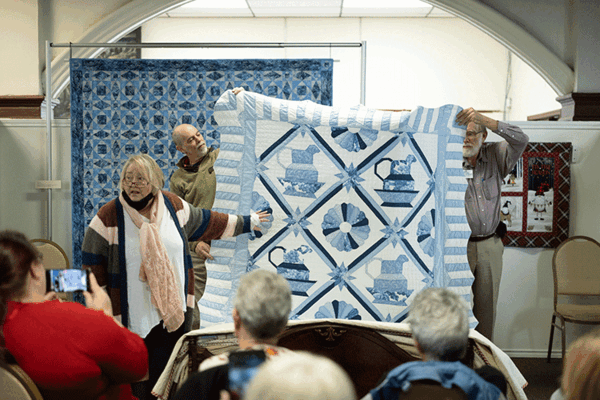 The second quilt, “Twinkle Stars,” was made by Audry Stewart in 2020 as part of a challenge organized by the Sew Sew Sisters of Alamo.
The second quilt, “Twinkle Stars,” was made by Audry Stewart in 2020 as part of a challenge organized by the Sew Sew Sisters of Alamo.
The group exchanged quilt strips with each other to make the one and three-fourths half square triangles in the design. But Stewart also used scraps from her grandmother and great grandmother’s scrap bags.
The next three quilts shown were owned by Catherine Raftery. They were made by Etta McKindrey, who was a farmer’s wife and the mother of 10 children. Born in 1873, she died in 1974; she quilted most of her adult life and was still quilting when she turned 100 years old.
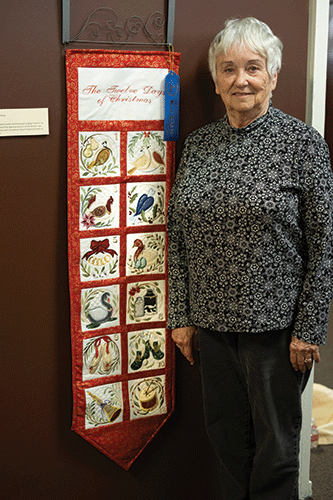 At the time, most quilts were made from old shirts and dresses and hers were no exception. One quilt, featuring different sizes of rectangles and squares, looked as if it were made entirely of material from old men’s shirts. The colors were blue green and brown, which would have been appropriate for men’s shirts at the time.
At the time, most quilts were made from old shirts and dresses and hers were no exception. One quilt, featuring different sizes of rectangles and squares, looked as if it were made entirely of material from old men’s shirts. The colors were blue green and brown, which would have been appropriate for men’s shirts at the time.
Another had striped blocks in different colors that may have come from pajama prints.
The quilts were neatly made. Lenz said the ladies got together in groups to quilt. If one lady did not do a neat enough job, the others would make her take the quilt apart and redo it, until it was neat enough to pass their inspection!
Her third quilt was a hand-stitched pinwheel design made of one-half inch squares and triangles. Lenz dated the materials used in the quilts back to the 1940’s and 1950’s.
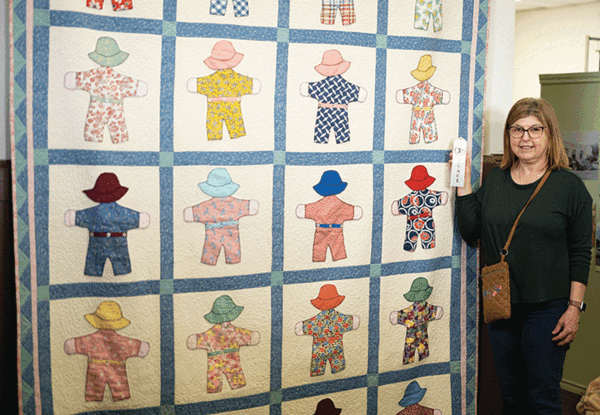 The next quilt Lenz displayed came from China. Called the Mariners’ Star, the blue and white quilt featured a variety of Dresden plates and pitchers. Lenz said when China entered the international quilt market, its quilts were made by women and children working in sweat shops for as little as one dollar a day to make the quilts.
The next quilt Lenz displayed came from China. Called the Mariners’ Star, the blue and white quilt featured a variety of Dresden plates and pitchers. Lenz said when China entered the international quilt market, its quilts were made by women and children working in sweat shops for as little as one dollar a day to make the quilts.
Catherine Raftery, who owns the quilt, bought it at the Jackson Street Market in Harlingen for $12, but would have paid much more.
The last quilt in the “Turning of the Quilts” belonged to Nancy Logan. It was an antique crazy quilt made in the 1800’s by her great aunt, who taught quilting to ladies in her church.
The quilt featured bright and colorful materials that were sewn onto a flannel blanket and had a lily-of-the-Valley embroidered on one edge. Lenz said that meant the quilt was dedicated to someone who died by the quilter.
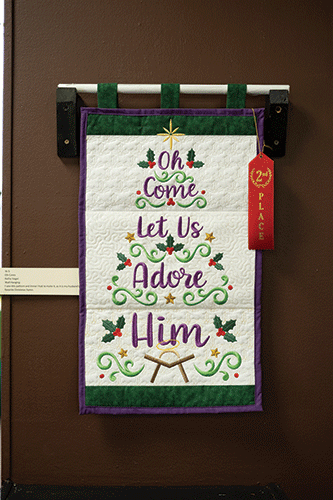 Winners were announced and ribbons passed out in the two categories. In wall hangings, third place winner was Cheryl Panter with “Gnome for the Holidays.”
Winners were announced and ribbons passed out in the two categories. In wall hangings, third place winner was Cheryl Panter with “Gnome for the Holidays.”
Second place went to Kathy Vogel with “Oh Come.” First place for wall hangings went to Carrol Moering for “Twelve Days of Christmas.”
In bed quilts third place went to Charlotte Vescova for “Angels Lost but Found.” Audry Stewart won second place for “Sweet Baby Kensley,” made for a new great niece.
First place and Best of Show went to Catherine Raftery for “Elm Creek.” A native of Ireland, Raftery took up quilting eight years ago when she came to the United States.
The large quilt featured a number of designs from buildings in New York City to log cabins with pinwheels and other designs.













